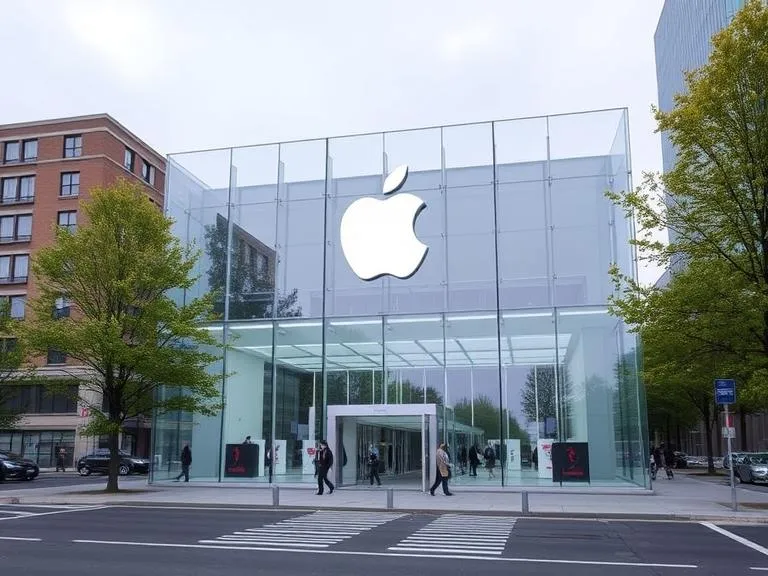Leading Through Digital Disruption of Amazon

Task 1: The case for change
Amazon, which started in 1994 by Jeff Bezos as an obscure online bookstore, now has grown into a multifaceted worldwide powerhouse. The beginning was with bookstalls, and then it expanded into a major electronic commerce, cloud computing, digital content streaming and development of cutting-edge technology. The core of Amazon’s performance lies in its customer-centric model, which allows it to apply data analytics and machine learning for personalized recommendations and shopping experience enrichment.
One of the key reasons why Amazon has become so appealing is its subscription service, Amazon Prime, which provides customers with features like express delivery, streaming services, and special offers. Thus, the AWS, which is owned by Amazon, is also leading in the cloud computing space serving the whole world through a wide range of services.
In addition to its basic services, Amazon is also continually making its way in cutting-edge technology field with investments in artificial intelligence, robotics, and drone delivery. The company is present around the globe in America, Europe, and Asia-Pacific region and beyond, through its logistics network which encompasses fulfilment centers and delivery facilities.
Organizations Digital Transformation
The transformation that Amazon underwent is driven by the e-commerce being a top player, COVID-19’s influence on shopping, and the rapid progress of technology. This entails two key components which includes adjusting to the increase of online retail and customer behavior after the pandemic and using the technology for innovation and efficiency:
E-commerce Dominance: Amazon is responsive to the fast pace of the internet-based shopping industry with the upgrading of its digital platform and the tailoring of products designed to fulfill the emerging customer requirements.
Impact of COVID-19: The lockdowns push people to shop online, compelling Amazon to rapidly enhance its digital capacity, in order to cope with the increased load and secure its operations.
Technological Advancements: Amazon is a company that uses AI, machine learning, robotics, and cloud computing to automate many processes, personalize customer experiences, and to introduce new ones. For example, they use drone delivery and cashier-less stores.
Objectives of Digital Transformation
- Enhanced Customer Experience: Amazon is targeting at smooth, personalized contacts as well as fast delivery options.
- Operational Efficiency: Streamlined operations, supply chain management, and productivity can be facilitated through the digital technology utilization.
- Scalability and Flexibility: With the help of AWS, for adjustable infrastructure to meet the demand, we will be leveraging fluctuation.
- Innovation and Differentiation: The expansion of Prime membership, AWS services, and new ventures in emerging technology fields.
Goleman’s Leadership Style
In navigating Amazon’s digital transformation, leaders can adopt various leadership styles outlined by Daniel Goleman:
Visionary Leadership: Leaders create a strategic vision for technology-based programs, which in turn, pave the way for innovation and make the staff members more open to change.
Coaching Leadership: Leaders concentrate on learning digital communication and adjusting to organizational changes by way of advice, processing, and help.
Democratic Leadership: Giving employees a chance to join the decision-making process promotes collaboration, innovation, and employee’s readiness to support change initiatives.
Transformational Leadership: The ability to improve performance, making employees adjust to the new technologies and methods of work, accompanies organizational change and innovation.
Pacesetting Leadership: Working in an environment characterized by high standards of performance might curtail innovation and cooperation, and in the long run, it could lower job satisfaction and motivation levels.
Commanding Leadership: If an attempt is made to enforce control, expect compliance, it may lead to a loss of creativity, to the hindrance of collaboration and even to resistance to change.
Managers in Amazon would be wise to use visionary, coaching, democratic and transformational leadership styles to support their teams as they go through their digital transformation journey. This paradigm views leadership as facilitating the shared vision, developing the employees, and involve them in decision-making, and creating a culture of innovation and collaboration, which are crucial to adapting technology and leading organizational change.
GROW Model
GROW model being the most effective model in the process of coaching and developing the leadership skills.
Goal Setting (G)
Undoubtedly, outline what each leader’s desired leadership goals are. Emphasize the leadership styles such as visionary, coaching, democratic, and transformational leadership styles.
Goals could be, create a powerful vision for their team, expand on leadership and mentoring skills, provide team members with active participation in the decision-making processes, and persuade for innovations and changes.
Reality Checking (R)
Evaluate the present leadership skills of every individual leader which are in accord with the leadership style needed.
Conduct 360 degree feedback assessments to gather perceptions from the peers, subordinates and supervisors on the areas that the leader is strong at and also those areas that need improvement.
Define clearly and specifically the improvements of behaviors and skills that are needed to become a visionary, coaching, democratic and transformational leader.
Options Generation (O)
Work with leaders together to propose various avenues and methodologies for the formation of their leadership styles.
Provide leadership development programs, workshops and seminars, the main topics of which are visionary leadership, coaching skills, democratic decision-making and transformational leadership practices.
Advise the managers to participate in action learning projects, cross-functional teams, or stretch assignments that give them opportunities to perfect and enhance their leadership skills by doing them practically in real-life situations.
Way Forward (W)
Come up with a personalized leadership development plan for each leader, which contains specific actions, time-frames, and personal goals of their leadership.
Set up recurrent check-ins and progress reviews to check the leader’s growth journey and to give ongoing feedback and assistance as needed.
Request leaders to do some self-review in order to assess the patterns of their actions, challenges, and successes, and to adjust their leadership style accordingly to achieve the appropriate leadership styles.
Congratulate and appreciate the leaders’ advancement and achievements through their development of visionary, coaching, democratic, and transformational leadership skills.
Task 2: Gaining Digital Business Agility
Hyper Awareness
The huge amount of data that Amazon gathers from customer touchpoints, sales, and operations can be uncovered by data-driven tools, allowing the company to be prompt in reacting to the market changes. AI and machine learning along with them, help to create awareness which can be used in generating statistical data and can also help in personalized customer recommendations.
Informed Decision-Making
Amazon can design decision support systems based on data-driven solutions and AI-driven insights to have intelligent decisions. Collective technological solutions facilitate smooth data exchange between groups of workers located in the different places that form a part of the organization, thus improving the organizational dynamics.
Fast Execution
Adoption of agile methodologies such as Scrum and Kanban help in the proper flow of the product development which in turn allows the business to adapt to the changing needs at a rapid pace Cloud computing services such as Amazon Web Services (AWS) and DevOps practices help automate and speed up the delivery of innovations by foster collaboration.
Evaluation of Initiatives
Let’s critically evaluate initiatives and digital technologies for each component of the Digital Business Agility Model.
Hyperawareness
Initiative: Customer Sentiment Analysis
Amazon’s customer sentiment analysis venture involves the process of monitoring social media, reviews, and feedback to gauge the customer perceptions and trends instantaneously. It will give a clue on the needs, and hence enable personalization and resolution of issues quickly. But even though this is the case, the following factors (context, human interpretation, and algorithm bias) also need to be given due consideration to ensure that the insights generated are accurate.
Digital Technology: The technical side of this involves Natural Language Processing (NLP)
NLP technologies give Amazon a possibility to read and understand unorganized text data that obtained from different sources including social media posts, customer reviews, and support tickets. NLP is a powerful language processing technique for Amazon that can mine valuable sentiment information, topics, and entities from big textual data.
Make Informed Decisions
Initiative: Forward-looking Analytics for Demand Forecasting
The predictive analytics is a tool used for the demand forecasting, which is the process of using historical sales data, market trends, and external factors to predict future sales of Amazon’s goods and services. By forecasting the demand precisely, Amazon is able to set up the inventory levels, pricing strategies as well as supply chain operations to the optimum, which results in the customer satisfaction improvements and cost savings.
Digital Technology: The phenomenon of Machine Learning (ML)
With the help of ML algorithms, Amazon can construct predictive models for demand forecasting, recommendation systems, fraud detection, and other stuff. Training models on big data sets with ML allows Amazon to detect seemingly hidden patterns, connections and trends, which in turn leads to more precise forecasts and meaningful data insights.
Execute Fast
Initiative: Agility of Development and Continuance of Deliverance
The agile development approach and continuous delivery of a project architecture consist of dividing tasks into small, doable items and developing the iterative progress, followed by collections of updates for customers. Through the implementation of agility, Amazon can thus promote faster innovation, be immediately reactive to changing market requests, and reduce the time it takes to have new products and features launched.
Digital Technology: Cloud Computing, DevOps services, and infrastructure as a service
Cloud computing platforms such as AWS (Amazon Web Services) allow for the creation of scalable infrastructure, the provision of on-demand resources and automated tools that help speed up application development, deployment and scaling. Utilizing cloud computing, DevOps approach, and CI/CD practices let Amazon automate infrastructure provisioning, go for streamlined pipelines, and deliver quicker cycles.
Task 3: Create a Digital Ready Culture
To embed a digital-ready culture within Amazon to support its digital transformation, let’s explore each feature identified by Think with Google (2017) and provide advice supported by academic literature and real case examples:
Putting Customers First
Advice
Amazon needs to be customer-centric through ongoing receipt of feedback, analysis of customer data, and prediction of their needs.
Encourage employees at all levels to empathize with customers and to make decisions that put the customers first by ensuring their needs are met and allaying their concerns.
Justification
Academic researches show that the companies oriented towards customers experience up to 60% revenue growth, are more profitable and have the highest customer loyalty over the competitors.
Case Example: Amazon’s unwavering customer-orienteers and convenience-centeredness making up its backbone, best characterized by projects like Amazon Prime and one-click ordering, in turn have been responsible for the rise of Amazon at the top of the e-commerce platform.
Creating a Collaborative Culture
Advice
Creating a culture of teamwork by removing barriers between departments, promoting knowledge as a common resource, and fostering cross-functional work groups.
Build such collaborative platforms and tools for employees to collaborate efficiently even when they are working together in the same office or are working remotely.
Justification
The studies indicate that a collaborative environment creates fertile ground for creativity, innovations and problem solving that eventually reflect on the company’s performance.
Case Example: “Two-Pizza Teams” concept of Amazon encourages the formulation of small, self-governing teams that collaborate to successfully accomplish tasks. This contributes to a high degree of innovation and the agility of the organization.
Instilling a Culture of Innovation
Advice
Build a setup that will motivate you to try in spite of the risks and to learn from your mistakes.
Encourage staff to investigate new concepts, technologies, and business strategies, and support them with resources, assistance, and incentives. Highlight and award merit and success, as well as persistent improvement and adaptation to new ideas.
Justification
The research that has been done indicates that an environment which is conducive to innovation enables organizations to survive in the face of market changes and to sustain their competitiveness in the long-run.
Case Example: The innovative culture at Amazon is evident in the initiatives such as Amazon Web Services (AWS), Amazon Go stores, and investments in new breakthrough technologies like Artificial Intelligence and drone delivery.
Becoming a Digital Champion:
Advice
Engage in digital literacy and fluency of the employees by offering training, resources and supporting individuals to learn and gain digital skills and information.
Ensure your employees can catch up with the revolution in digital trends, technologies, and industry best practices by providing continuous learning and professional development. Utilize workforce to lead digital campaigns within their teams and departments, and thus turning the tables and using the base of the pyramid for digital transformation.
Justification: The research demonstrates that organizations with employees who match the digital skillset will be able to shun digital technologies for digital transformation initiatives.
Case Example: Amazon allows its employees to experiment and innovate with the use of digital technology through the infrastructure such as “Amazon technical Academy” and initiatives for example “Alexa Prize Challenge” where teams are encouraged to grow conversational artificial intelligence.
Task 4: Steer Collaboration:
Job Description: Chief Collaboration Officer (CCO)
Role Overview:
The post of CCO, which is an executive position, is accountable for building a collaborative culture, eliminating barriers between functional units and teams, and spearheading cross-functional projects to bring the organization on track with the goals set. CCO will fill the role of the key player in initiating the process of the improvement of communication, alignment, and synergy within the system that will, in turn, lead to higher innovation, performance, and efficiency.
Key Responsibilities
Strategic Leadership
Devise and laud a strategic plan and pathway for collaboration schemes that will be in line with the organization’s mission and targets.
Collaborate with executive leadership to determine the aims, allocate resources and assess the effectiveness of collaboration efforts in the organization’s performance.
Cross-Functional Collaboration
Encourage teamwork and communication across departments through the creation of open atmosphere grounded on trust and knowledge exchange.
Identify opportunities to collaborate, synergize, and jointly innovate across different functional sectors to add value and drive the innovation process.
Process Optimization
Conduct an audit of the current workflow, process, and communication channels in order to pinpoint the collaborative barriers and then utilize the methods to make the collaboration more streamlined.
Adopt tools, technologies, and developing techniques for better teamwork, communications, and project management throughout the organization.
Change Management
Conduct organizational change projects to construct a cooperative culture and attitude, tackling resistance and eliminating the obstacles for collaboration.
Act as a leader, guide and support staff and teams in their transformation into new working and collaboration approaches.
Performance Monitoring and Evaluation
Develop KPIs the key performance indicators) and metrics to evaluate the success of collaborative initiatives and keep track of whether collaboration goals are being achieved.
As a matter of routine, measure and report on the effects of a collaboration on business results, employee engagement and customer satisfaction.
Stakeholder Engagement
Develop and maintain links with the head of the organization, department’s heads and team leaders, who are key stakeholders.
Play a role of a mediator and spokesperson for synergy initiatives, making sure that different parties will be working under one umbrella with the same aim as the organization.
Advice on Increasing Collaboration
Besides showing a collaborative leadership style, the CCO should also actively engage with teams, seek opinions from stakeholders, and model those behaviors that will promote collaboration.
Provide training, workshops, and employee resources to enable employees to develop the skills, tools and attitude to work together effectively.
Provide communication and information-sharing platforms and collaboration tools that would facilitate the process of project collaboration as the remote teams work together.
Develop channels for comments, advice, and effectiveness of the improvement process and collaboration to foster a culture of constant development and collaboration.
Case Study Example:
Already in 2016, the German Telekom made her his Chief Collaboration Officer. Nemat was assigned to reduce factionalism and enhance collaboration among the company’s multiple business units. She started cross-functional workshops, opened up team communication channels, and introduced new collaboration tools. Consequently, Deutsche Telekom now have achieved greater efficiency, faster decision-making, and high-quality customer experience by making effective collaboration and knowledge sharing.



















































